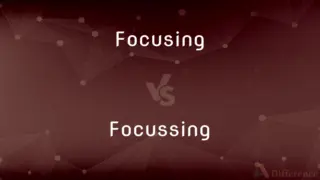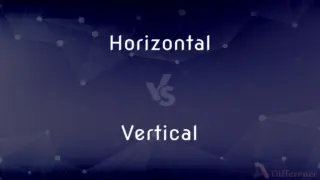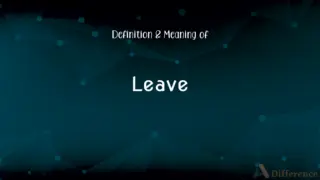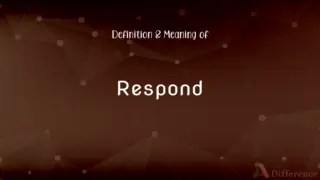Horizontal Relationships vs. Vertical Relationships — What's the Difference?
By Tayyaba Rehman — Published on November 18, 2023
Horizontal Relationships refer to connections among equals, while Vertical Relationships pertain to connections between different levels or hierarchies.

Difference Between Horizontal Relationships and Vertical Relationships
Table of Contents
ADVERTISEMENT
Key Differences
Horizontal Relationships are those connections between individuals or entities that function at the same level or hierarchy. In a business context, for instance, this could mean a relationship between two managers of the same rank. Such relationships tend to be cooperative and involve collaboration, sharing of resources, or mutual problem-solving. On the other hand, Vertical Relationships are those that exist between individuals or entities at different levels within a hierarchy. For instance, in an organizational setup, the relationship between a manager and a subordinate would be a vertical one. These relationships are typically characterized by authority, supervision, or a flow of directives.
Horizontal Relationships emphasize peer interaction and mutual benefit. In friendships or partnerships, such relationships are usually founded on shared interests, equality, and mutual respect. These connections play a crucial role in fostering teamwork and collaboration in many professional settings. Vertical Relationships, however, are more about guidance, mentorship, or command. In familial settings, the relationship between a parent and a child is vertical, with the parent typically guiding or instructing the child.
Horizontal Relationships, in academic or educational environments, might refer to collaborations between researchers or educators of the same rank or tenure. These are partnerships that are aimed at pooling resources or sharing expertise to achieve common goals. In contrast, Vertical Relationships in such environments could refer to the dynamic between a teacher and a student, where the flow of knowledge is mostly one-directional, from the more experienced to the less experienced.
In essence, while Horizontal Relationships provide platforms for mutual cooperation among peers, Vertical Relationships define interactions within structural hierarchies, where roles, responsibilities, and power dynamics may vary significantly.
Comparison Chart
Hierarchy
At the same level
At different levels
ADVERTISEMENT
Nature
Cooperative and collaborative
Authoritative or directive
Examples
Friendships, peer collaborations
Parent-child, manager-employee
Flow of Information/Power
Bidirectional, mutual
Often one-directional, top-down
Key Characteristics
Equality, shared interests
Authority, guidance, mentorship
Compare with Definitions
Horizontal Relationships
Connections that prioritize teamwork and collective effort.
In the committee, Horizontal Relationships played a key role in achieving consensus.
Vertical Relationships
Bonds where one party guides, mentors, or instructs the other.
The Vertical Relationships in her family were rooted in respect and guidance.
Horizontal Relationships
An association based on mutual respect and equality.
Their Horizontal Relationships as co-authors ensured equal contribution to the research.
Vertical Relationships
Connections existing between different levels of a hierarchy.
The Vertical Relationships in the company dictated the flow of communication.
Horizontal Relationships
A connection between peers operating at the same level.
The Horizontal Relationships among the team members fostered a sense of unity.
Vertical Relationships
Associations characterized by authority or supervision.
Vertical Relationships between teachers and students shape the educational dynamic.
Horizontal Relationships
Collaborative interactions without hierarchical distinctions.
Horizontal Relationships in the workshop allowed for free exchange of ideas.
Vertical Relationships
Interactions with distinct roles and power dynamics.
The organization's efficiency was attributed to clear Vertical Relationships.
Horizontal Relationships
Bonds formed on shared interests or objectives.
The club's success was due to the Horizontal Relationships between its members.
Vertical Relationships
Connections where knowledge or directives flow from top to bottom.
Vertical Relationships in the army ensure discipline and order.
Common Curiosities
How do Vertical Relationships play out in academic settings?
In academia, Vertical Relationships can be seen between professors and their students or between senior and junior researchers.
Are Vertical Relationships always authoritative?
Not necessarily. While Vertical Relationships often involve authority, they can also be about guidance or mentorship.
Can a Vertical Relationship become horizontal over time?
Potentially. As individuals grow in experience or stature, the nature of relationships can evolve.
How do power dynamics differ between Horizontal and Vertical Relationships?
In Horizontal Relationships, power is often shared, while in Vertical Relationships, power may reside more with the higher-ranking individual.
Are Horizontal Relationships less formal than Vertical Relationships?
Not necessarily. Formality is context-dependent and not solely based on the relationship's orientation.
Can Vertical Relationships exist among peers?
Typically, no. Vertical Relationships imply a difference in level or hierarchy.
Can organizations function without Vertical Relationships?
While some organizations prioritize flat structures, most have some form of Vertical Relationships for clarity in roles and responsibilities.
What do Horizontal Relationships typically emphasize?
Horizontal Relationships emphasize equality, collaboration, and mutual benefit.
Can Horizontal Relationships exist in a family setting?
Yes, siblings often have Horizontal Relationships with each other based on mutual respect and equality.
How do Horizontal Relationships affect team dynamics?
Horizontal Relationships often promote teamwork, mutual respect, and collective problem-solving.
Is collaboration easier in Horizontal Relationships?
Generally, Horizontal Relationships facilitate easier collaboration due to the absence of hierarchical barriers.
Can a single individual be part of both Horizontal and Vertical Relationships?
Absolutely. An individual can have Horizontal Relationships with peers and Vertical Relationships with superiors or subordinates.
How are communication patterns different in Horizontal and Vertical Relationships?
In Horizontal Relationships, communication tends to be bidirectional and open, while in Vertical Relationships, it may be more directive or top-down.
How do Horizontal Relationships benefit businesses?
They foster collaboration, innovation, and often lead to a more inclusive work environment.
In what settings are Vertical Relationships most evident?
Organizational, familial, and educational settings often showcase clear Vertical Relationships.
Share Your Discovery

Previous Comparison
Lipstick vs. Lip Balm
Next Comparison
Line Spectrum vs. Band SpectrumAuthor Spotlight
Written by
Tayyaba RehmanTayyaba Rehman is a distinguished writer, currently serving as a primary contributor to askdifference.com. As a researcher in semantics and etymology, Tayyaba's passion for the complexity of languages and their distinctions has found a perfect home on the platform. Tayyaba delves into the intricacies of language, distinguishing between commonly confused words and phrases, thereby providing clarity for readers worldwide.













































